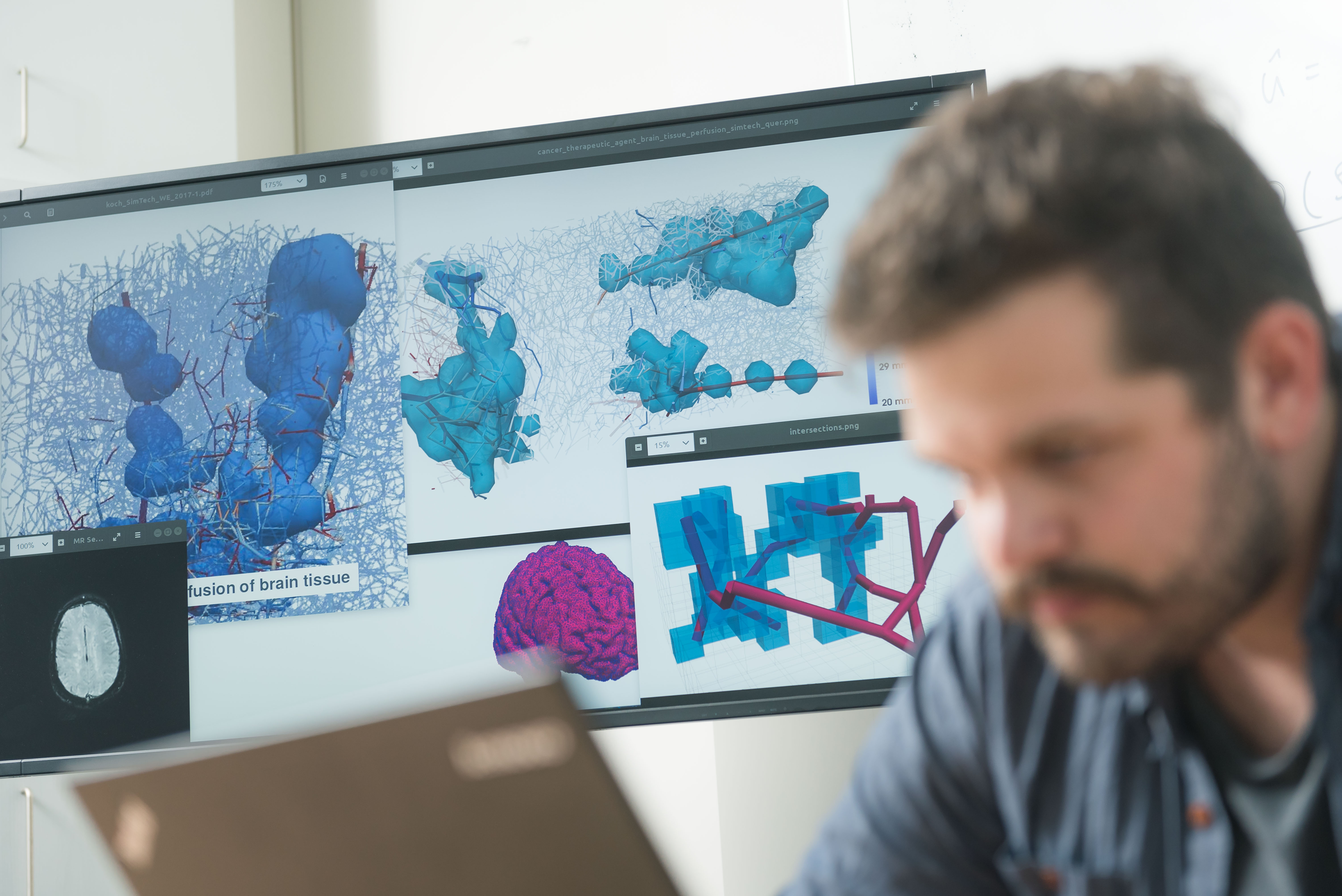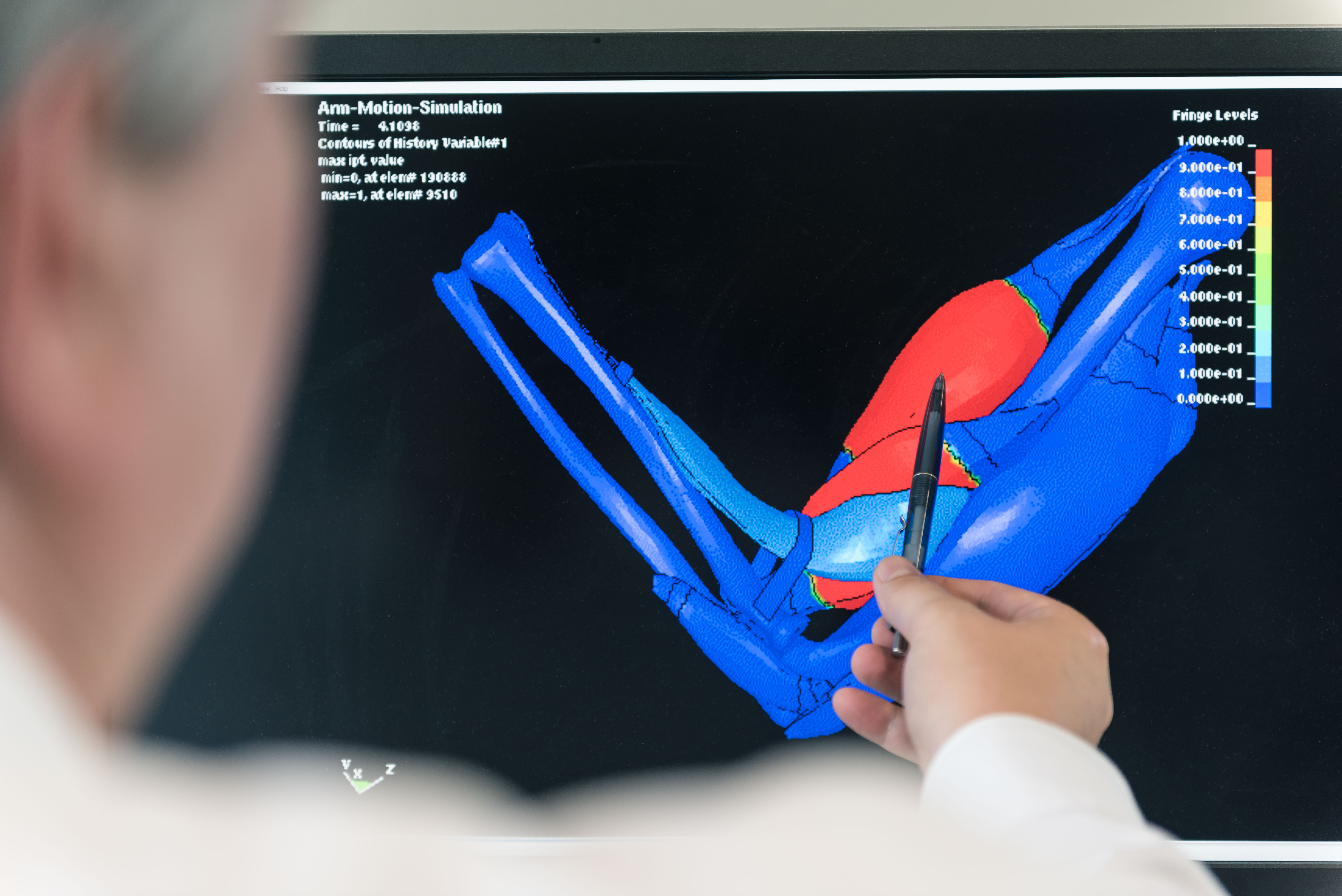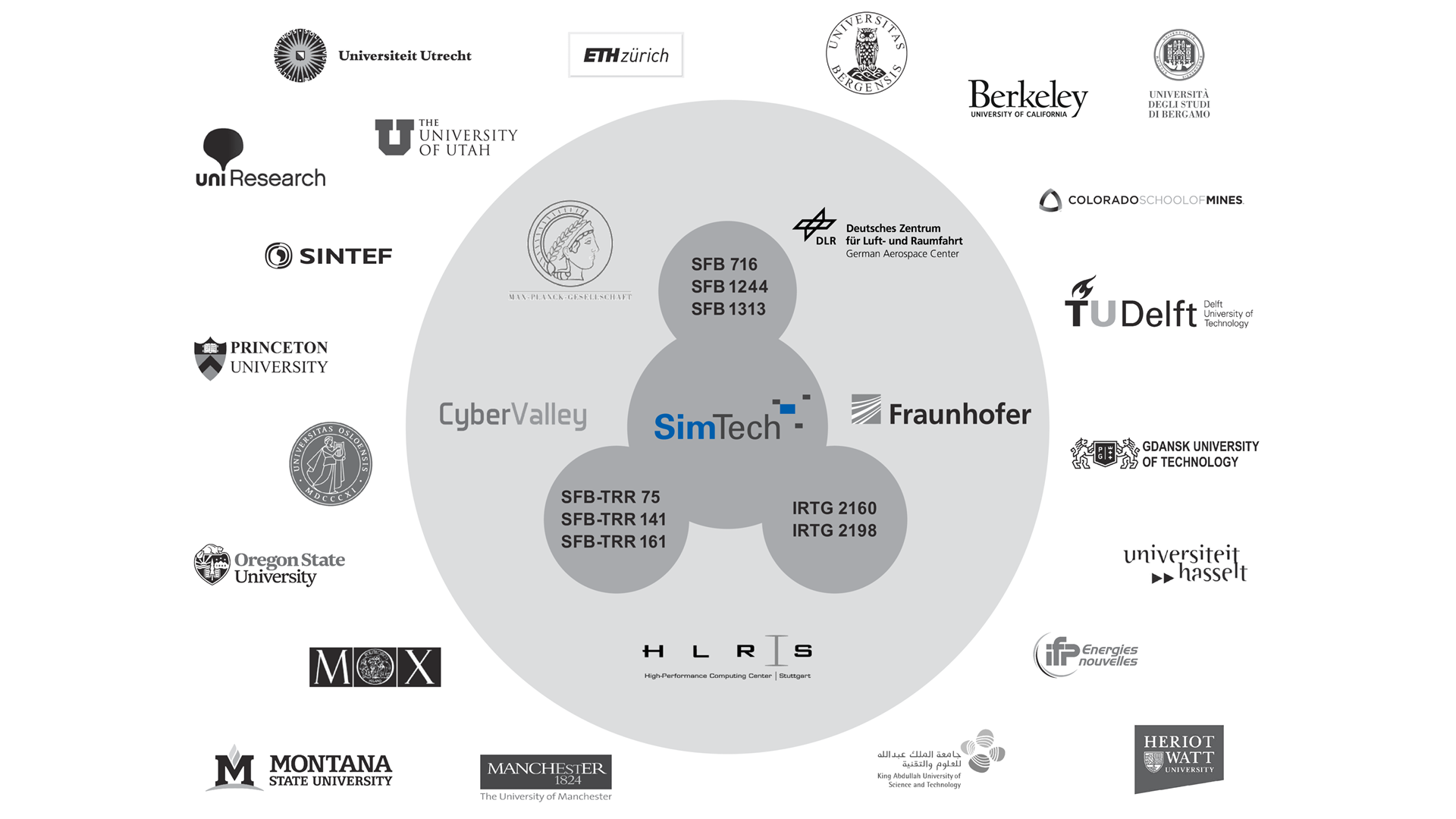Simulation or the question “What if?”
If you look up the meaning of the word “simulation” in the German Duden, the first entry is the explanation “to pretend” – i.e. “to act as if”. However, if you read on, simulation can have a different meaning: imitation. It stands for “what if?”. It is about reproducing processes and facts on the basis of models or imitating them realistically. For centuries, complex phenomena have been described by models in the sciences. Simulations enable us to understand important aspects of the systems described in this way, to predict changes and to decide how to control such systems.
Visualizations transform data from computer simulations into graphic representations. Using these images, the information from the simulations can be interpreted and analyzed easier. Visualizations illustrate the simulation results.
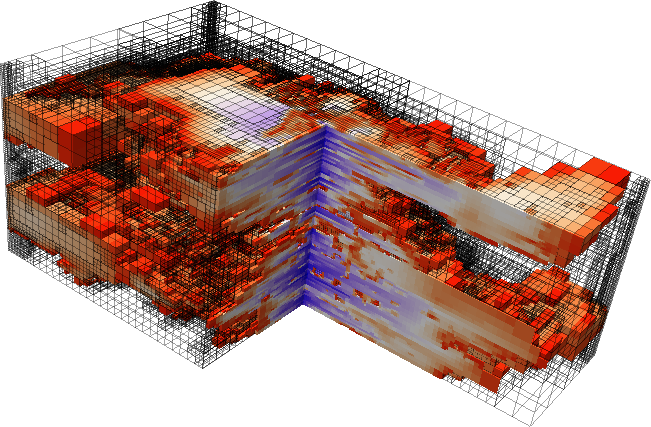
What is a model? What is a simulation?
Simulations are created on the basis of models. In this way, different scenarios can be simulated which are too expensive or too dangerous in reality or which are not visible to the naked eye. Simulations make the invisible visible.
Example from the field of biology:
Model: Virtual reproduction of the human brain
Simulation: How does the brain behave when taking certain medication? In this way, the transport of medications can be made visible.
Simulations make processes visible.
Vivid examples can be found in the simulation gallery.
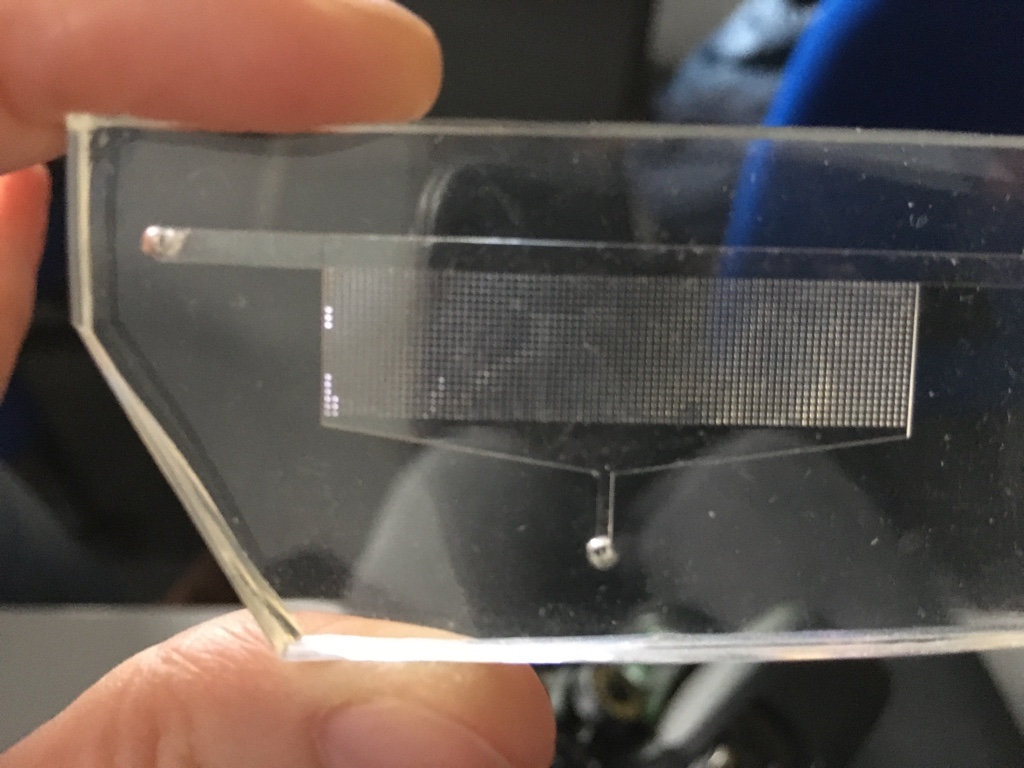
Credits: University of Stuttgart / SFB 1313

Credits: Utrecht University
This is a model of a porous structure made of silicone (1). Researchers can conduct different lab experiments with this model.
A liquid can be made to flow through this model. Analogous experiments (2) are often very expensive. Laboratory experiments generate data, which in turn can be used for virtual experiments (models and simulations). Simulations can be repeated as often as required without incurring enormous costs.

Credits: University of Stuttgart / SFB 1313
This is a simplified model of a porous structure from the analog experiment, which was reconstructed on the computer with special modeling software. The grey squares illustrate the solids. The black background illustrates the interfaces – the pores.
Researchers can conduct virtual experiments – simulations –with the help of this computer model. For that, they use the data acquired from the analog experiment. The simulations help to examine whether the experimental data from the analogue experiments are correct.
What is source code?
Source code is text written in programming language, which is structured in lines.
The text consists of different components, which are applied to formulate commands. A simulation is built with the help of the source code. The source code is important because it alone is responsible for how a simulation looks like and for the content. If only a single character is set incorrectly, the simulation is affected and becomes erroneous.

Credits: University of Stuttgart / LH2
Credits: University of Stuttgart / LH2
Credits: University of Stuttgart / LH2
What is DuMuX?
DuMuX is a software (= compute program), with which models can be programmed. On the basis of these models, simulations can be performed.
DuMuX means “DUNE for Multi-{Phase, Component, Scale, Physics, …} flow and transport in porous media”.)
DuMuX is a open source software that has been developed at the University of Stuttgart.
What is an open source software?
Software, public for the public, is called open source software. That means that the source code is freely accessible. In this way existing knowledge can be easily transferred and exchanged with others.
Other examples of open source software or computer programs are Firefox, Google Chrome, Linux or Open Office.

Credits: PantherMedia / bakhtiarzein
Holger Steeb, Professor at the University of Stuttgart and Principal Investigator within SFB 1313 (the Collaborative Research Center on porous media), and the Cluster of Excellence SimTech, gives us an insight into experimenting with porous media. He and his team show us, how important experiments are to better understand hydro-mechanical properties of porous materials in order to develop mathematical models, which can be used in simulations and for technical applications. In the “Porous Media Lab” the team is aiming to make porous media transparent by using high resolution x-ray computer tomography. Based on CT-scans, the pore space can be visualized, characterized and segmented for subsequent direct numerical simulations.
From the experiment to the simulation: How the “porous medium” asphalt becomes visible
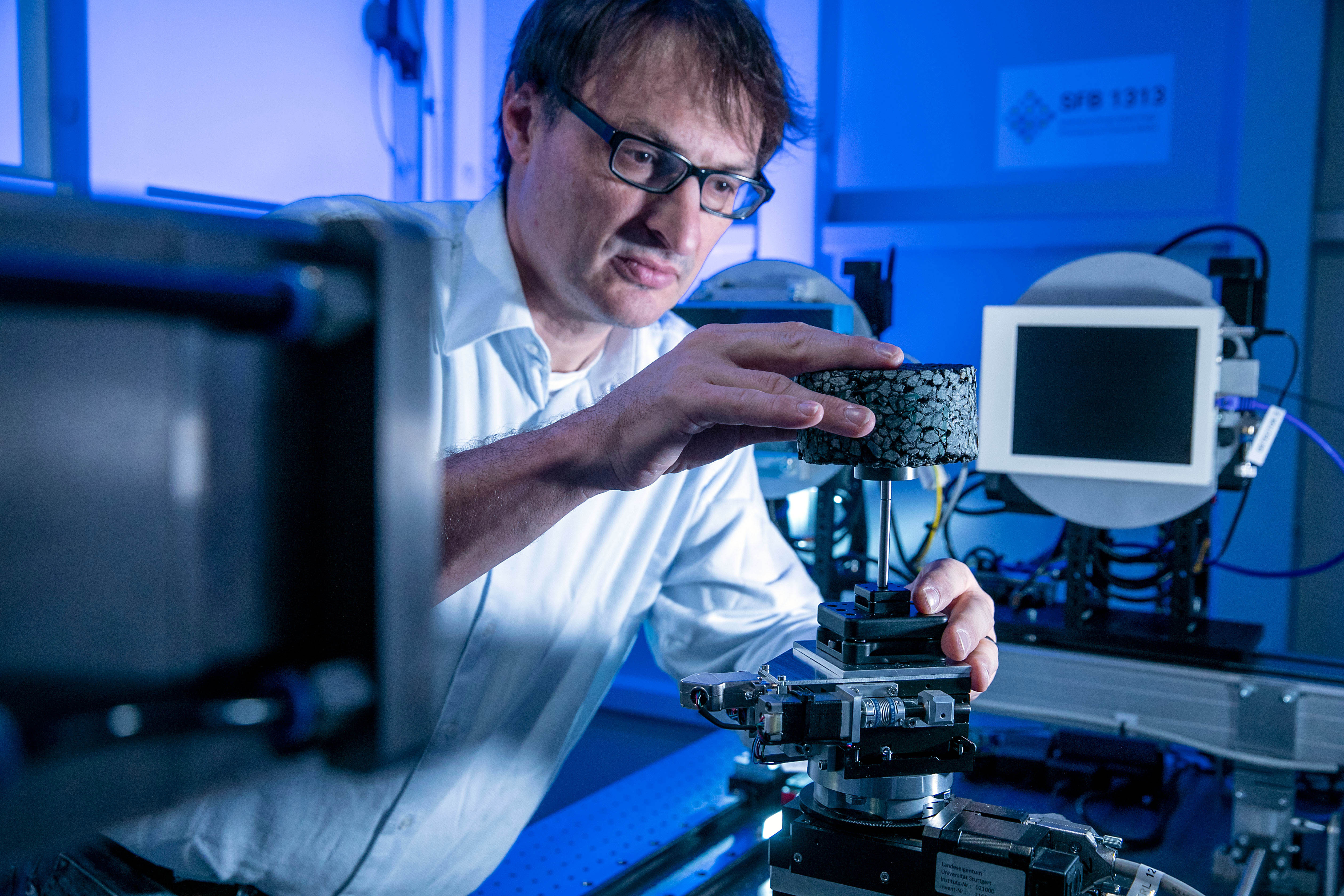
Credits: Universität Stuttgart / Uli Regenscheit
Credits: University of Stuttgart / Holger Steeb
Do we have holes in asphalt? “Holes“ are also denoted as “pores” by porous media scientists. The effective material properties of asphalt and further porous materials strongly depend on the properties of these pores. Unfortunately, we are not able to classify the pore space as e.g. asphalt is an intransparent material. Therefore, trying to answer the question about “holes in asphalt” anyway, we are using X-Ray Computed Tomography, a technique widely used in medicine, to make asphalt transparent and to characterize the pore space. Afterwards, high-resolution 3D CT-scans are for us the image-based sources for further investigations, i.e. multi-scale simulations for the determination of effective physical properties of porous media.
If we examine different objects or materials from the “outside,” the porous structure they have in common is often not visible to us. We have to zoom into them with a microscope to be able to distinguish the solids and the void spaces between them. There are different scales on which porous media can be examined more closely.
There is a distinction between the micro and macro scale.
Micro scale: this is the insight view, i.e. a zoom into the porous medium. In this way, the porous structure and pore geometry as well as the distribution of the fluid and solid phases become visible. Problems that can be described on the microscale are very small.
Macro scale: the macro scale (also called Darcy scale or REV scale) uses averaged “views” by defining properties that correspond to micro-scale effects.
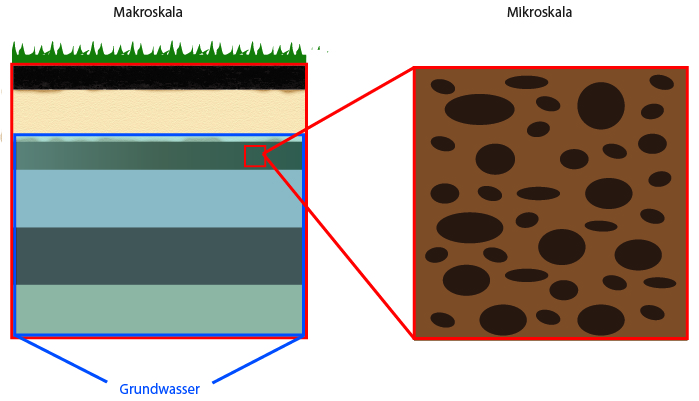
Credits: University of Stuttgart / SFB 1313
Porous media research happens on different scales. They can be explained with the help of the example of “soils”.
If we look at an earth pile under the microscope, we can see that the individual grains of earth lie on top of each other, next to each other or below each other. The grains build the porous structure. The grains are the “solids”, and the void space between the solids is the “pore space”. This pore space is permeable and liquids and gases can easily flow through it.
The micro scale can be digitally recreated. To that end, researchers create a model that corresponds to the reality. With this model different scenarios can now be carried out.
When people talk about simulations today, they are usually computer simulations. Here, processes or objects are simulated by the computer and reality is reconstructed virtually. By abstraction, a model is created, on which experiments are carried out. In such digital experiments, individual parameters, possible effects and effects under different influences can be tested virtually. In this way, we can also look back into the past or reach unreachable areas.
But it is not possible to do entirely without experiments, because sometimes simulations provide several different explanations for one phenomenon. Thanks to simulations, however, experiments are much more targeted in these cases.
Computer simulations are the third pillar of science, alongside experiments and theory. They help scientists to recognize connections, uncover gaps in knowledge and understand processes.
Simulations are an important tool for many disciplines. Whether it is meteorology, medicine, mechanical engineering, physics and chemistry, forestry and agriculture, sports science, environmental technology, engineering science or materials research – progress today is hardly conceivable without simulations. However, simulations do not only play an important role in science and technology, but are also becoming increasingly important in business, politics and the social sciences.
Simulations are used when…
![]()
… a system is very large or very small.
Due to the size of the universe, experiments can often only be carried out at great expense. Simulations are also often used on a small scale – in the field of atoms and molecules.
![]()
…experiments are too expensive.
Real tests, for example on the behaviour of machines, are very expensive and time-consuming. Crash test simulations save resources and a lot of effort, because in reality fewer cars have to be destroyed.
![]()
…experiments are too dangerous.
Some experiments are far too dangerous in reality. These include, for example, experiments on core meltdown or on processes in our environment such as the storage of CO2 in the soil, so-called CO2 sequestration.
![]()
…experiments are ethically unacceptable.
In some areas, experiments are prohibited for ethical reasons, for example in medicine or because they endanger others. This is why pilots in their training first train virtually on flight simulators before they actually fly.
![]()
… the system does not yet exist in reality.
Simulations also provide predictions about systems that do not yet exist. For example, the properties of new materials can be simulated before they are produced in the laboratory.
![]()
… processes run very fast or slow.
For example, when galaxies form or die, it takes many millions of years. The explosion of a supernova, on the other hand, happen very quickly. In computer simulation, you can virtually adjust the time.
In which application areas do we use simulations?
Driving and flight simulator | weather forecast | climate simulations | crash tests | simulation of production plants | spread of drugs in the body | spread of tumors in the body | simulation of geological processes | product development | automobile development | big bang | explosion behaviour | development of materials | election forecasts | risk analyses | company analyses | population trends | effects of money market instruments | forecasts in the insurance industry | simulation of political reform plans | simulation of global capital and commodity flows in stock trading | simulation of historical events | development of prostheses | …
Which disciplines use simulations?
Bioengineering | Food chemistry | chemistry | genetics | disease research | nanotechnology | diagnostics | biology | biotechnology | sports science | pharmaceutics | medical technology | machine learning | AI | mechanical engineering | mechatronics | electrical engineering | space technology | media technology | construction | civil engineering | architecture | automotive engineering | history | linguistics | physics | mathematics | computer science | astronomy | landscape ecology | geodesy | climate research | geology | sustainability studies | renewable energies | hydrology | water management | process engineering | …
And this is how it works!
Explaining simulations using the example of the human gait
Credits: SimTech / Storz Medienfabrik GmbH
Real process
The human gait is a complex process. This becomes particularly clear when a human being loses the ability to walk. In order for this ability to be restored, for example through highly developed prostheses, researchers need to gain a better understanding of how the gait works. This is where simulations help.
Modeling
Determine the structures and influences involved. Formulation of interactions. Creation of a mathematical model.
Numerics
Inserting concrete values into the formulas of the mathematical model. Translating the model into algorithms.
Implementation
Developing a software for the simulation in order to calculate it on the computer.
Visualization
Visualize abstract simulation results and data
Analysis
Evaluation of the simulation results and comparison with the real experiment
Reality check
Do the simulation results match the reality?
Model adjustment
Incorporation of the findings into the process and improvement of the computer simulation
Credits: University of Stuttgart / SFB 1313 / Stefan Scheller / Kilian Weishaupt and Utrecht University / Matthijs De Winter
This video shows the results of a simulation which was processed with the help of data visualization. With the help of simulations, different situations can be simulated, which cannot be repeated or varied in the laboratory due to limitations on time and costs. This simulation shows how liquid flows through the porous medium. It moves in a streamlined way around the grey solid squares and flows from left to right.
The experts in the area of simulations
Who are we?
Credits: SimTech / Storz Medienfabrik GmbH
The Cluster of Excellence „Data-Integrated Simulation Science” at the University of Stuttgart has been in existence since 1st January 2019. It is funded by the German Research Foundation (DFG) within the framework of the German excellence strategy until 2026. In our Cluster, which is by the way one of two Clusters of Excellence at the University of Stuttgart, around 150 people from seven faculties of the University work together in interdisciplinary research teams. At the same time, we also take care of the next generation of young scientists within our study program Simulation Technology, our competition PlaNeT SimTech and our graduate school GS SimTech.
What do we do?
Our work focuses on the integration of simulation and data science. This means that we use the ever-increasing amount of data from various sources for our simulations from the very beginning in order to improve their accuracy. This enables us to make our models more reliable and thus make predictions that are more accurate. Scientific fundamentals are always taken into account. The knowledge gained in this way can be used in almost all areas: simulation of the musculoskeletal system, development of prostheses, development of materials, effects of geothermal drilling, development of patient-specific drugs – to name only a few.
For this purpose, the exchange and cooperation with other national and international research institutions and industry are very important.
SimTech-Research
Credits: SimTech / Storz Medienfabrik GmbH
We conduct research in the field of simulation and data science. It is based on three so called “Visionaly Examples”: Engineered Geosystems, Digital Human Model and Virtual Materials Design. In order to turn these visions into reality, it is necessary to develop basic methods that can be applied to all areas and are thus are applicable across visions.
Our research is organized in interdisciplinary project networks.
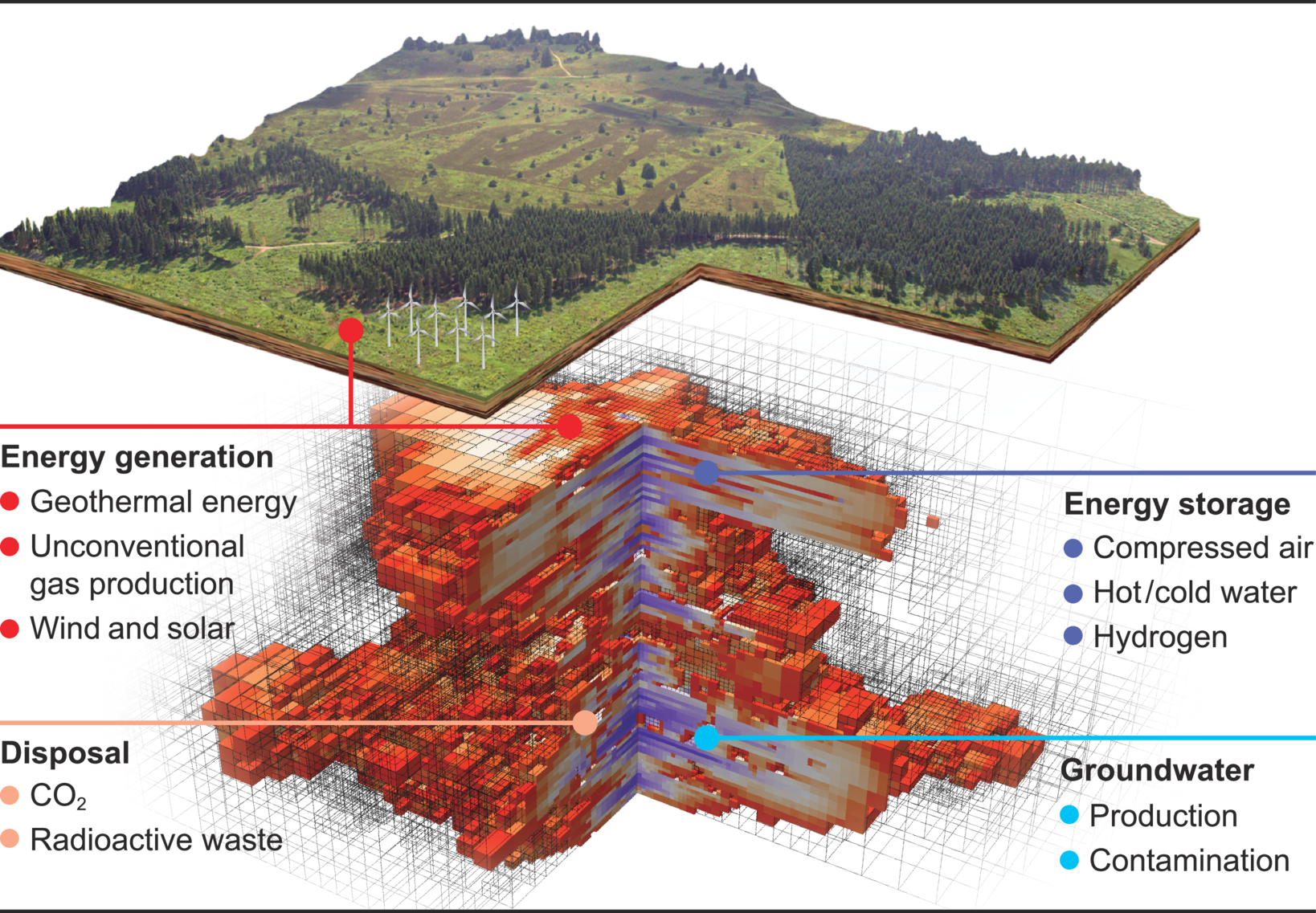
Credits: University of Stuttgart / SimTech
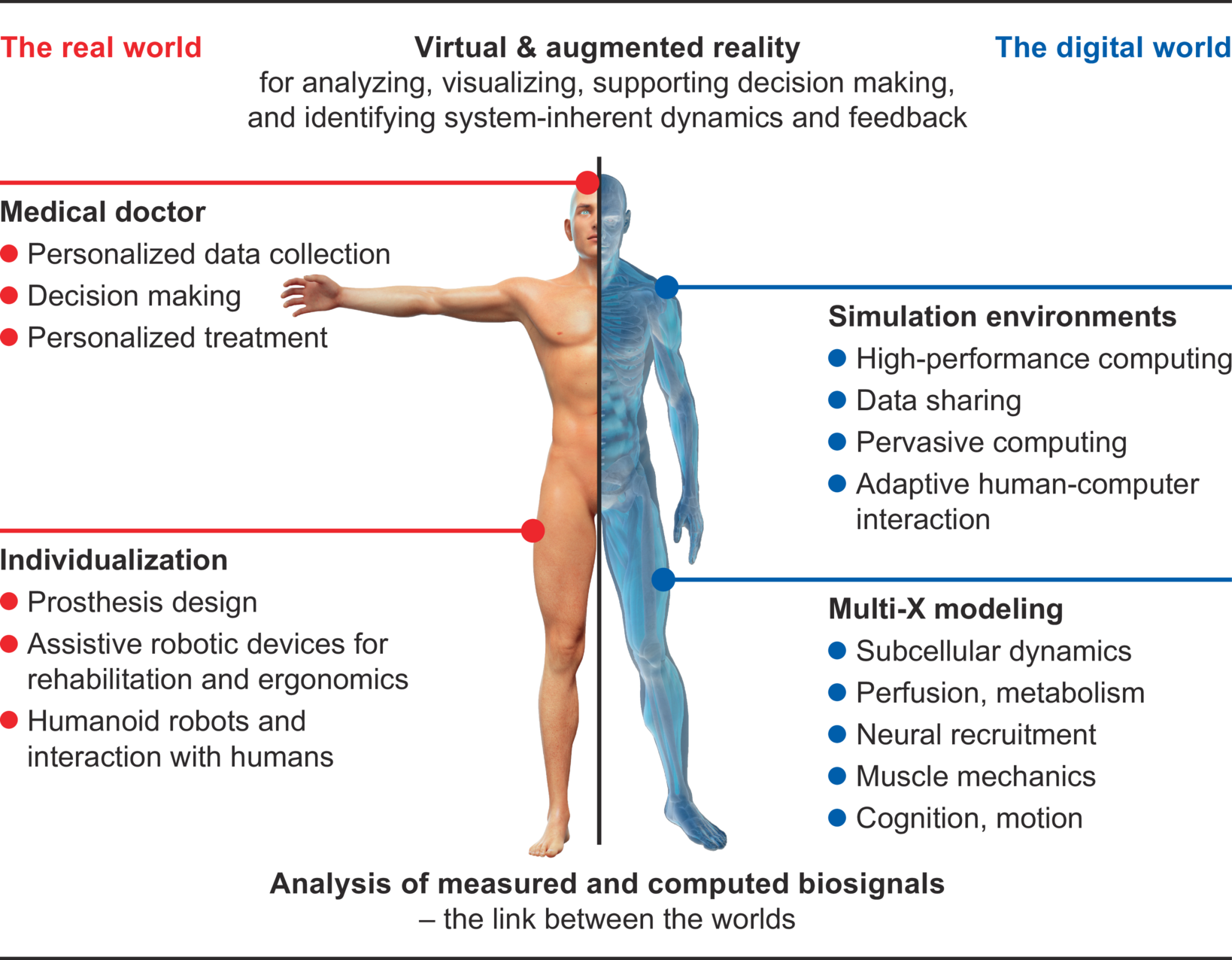
Credits: University of Stuttgart / SimTech

Credits: University of Stuttgart / SimTech
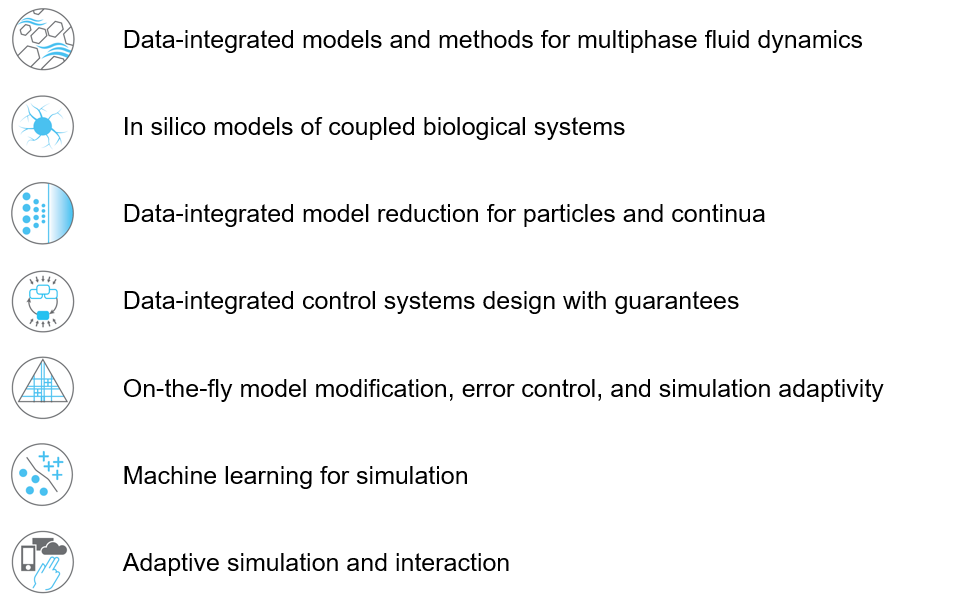
Credits: SimTech / VISUELL
Study Program „Simulation Technology“
The interdisciplinary study program „Simulation Technology“ combines the fields of mathematics, engineering, computer science and natural science. Since 2010, students have been able to study the six-semester Bachelor’s course and since 2013 they have been able to continue their studies in the consecutive Master’s course. An excellent basis for a subsequent doctorate. Perhaps even in the GS SimTech, our graduate school.
Student competition Planet Simtech
Since 2015, the SimTech Junior Academy has been organising the PlaNeT SimTech school competition. Solving problems from natural sciences and technology is the motto here. The competition is for those students who are in their last two years of high school and enjoy mathematics, puzzles, engineering problems and tinkering. The team that finds the best solution for our modelling challenging task, such as “How much fuel do you need for a manned Mars mission?” can win up to 500 EUR.
Simulation gallery
1: Root water uptake by young, growing root systems
This simulation shows the growing root systems of two young plants. The plants take up water from the soil in a plant pot. The soil eventually dries out.
Model: soil and root
Simulation: water transport and root growth
Roots are visualized by brown tube segments. Blue soil corresponds to high water content, brown soil means low water content.
In-depth text
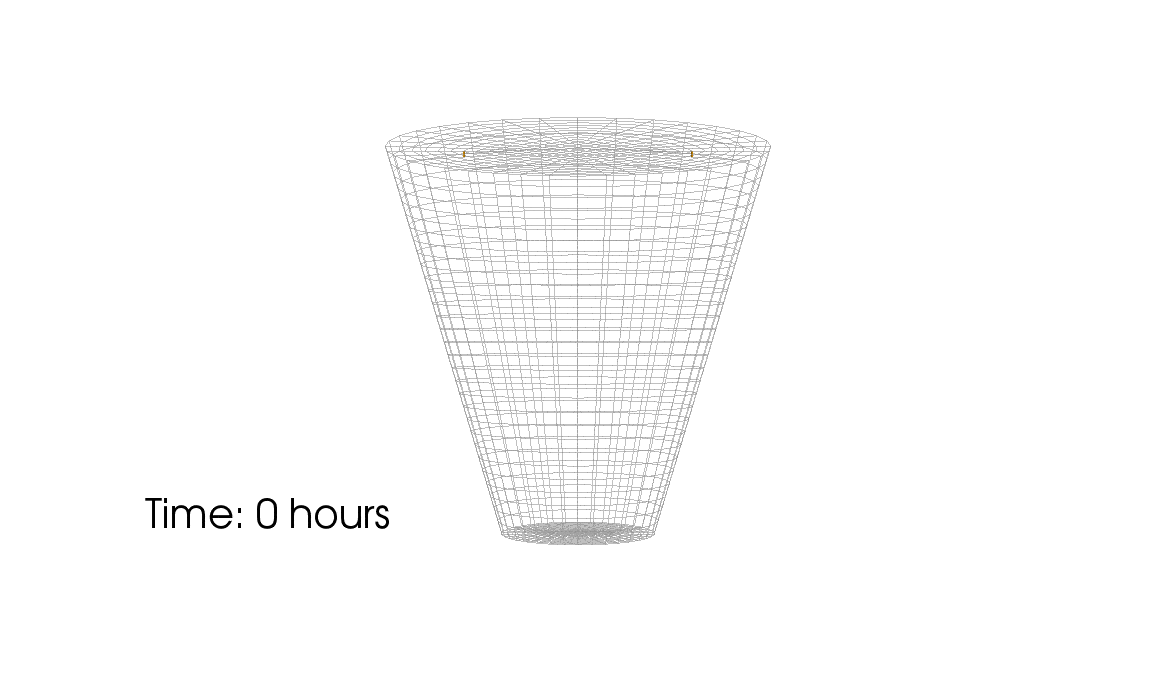
Credits: University of Stuttgart / Timo Koch
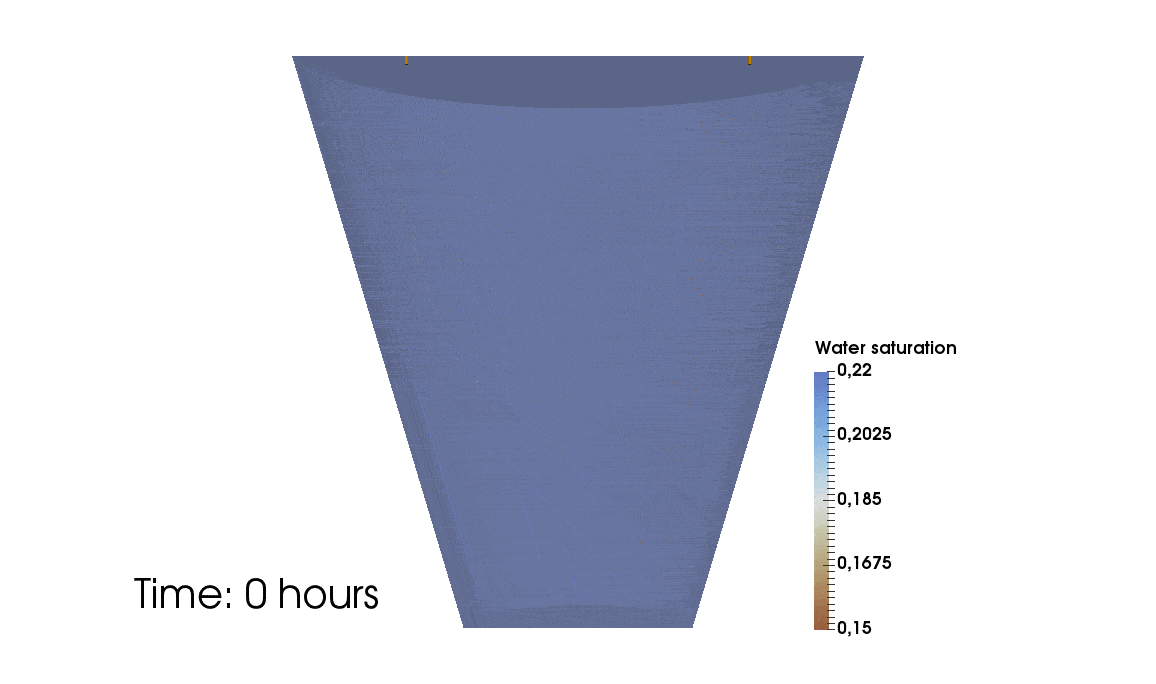
Credits: University of Stuttgart / Timo Koch
2: Flow through rock with fractures
This simulation shows the pressure-induced flow of oil through a cylindrical rock sample, in which elliptical fractures are contained. The pressure changes caused by the injection lead to the dilation of the fractures.
Model: porous rock and fractures
Simulation: flow and deformation
The rock is depicted in gray, and the blue region shows until which point the oil has been transported through the sample. The arrows show the velocities of oil within the sample and the deformation of the sample is strongly exaggerated in this visualization.
In-depth text
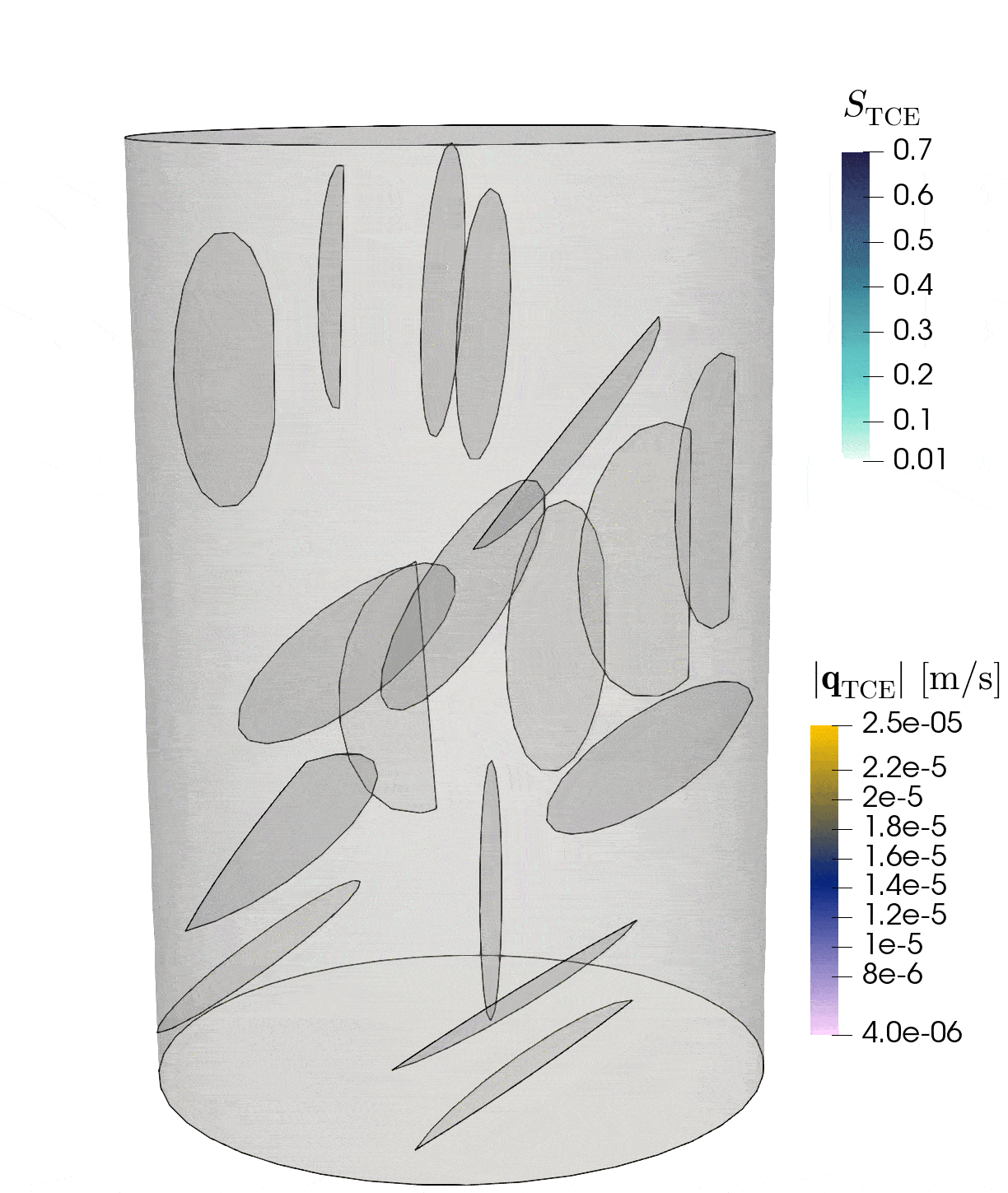
Credits: University of Stuttgart / Dennis Gläser
3: Contrast agent perfusion in capillaries and embedding tissue
This simulation shows contrast agent transport in the smallest blood vessels (microcirculation). Blood is simplified as a fluid without particles. The cell content is accounted for by an increased flow resistance. The porous tissue surrounding the blood vessels is described by an average description. This means that individual pores between cells are not visible.
Model: brain tissue and capillaries
Simulation: blood flow and contrast agent transport
The capillary network is taken from a rat brain and represents all blood vessels contained in a 1mm by 1mm by 2mm tissue sample. The contrast agent is visualized as a black cloud. Contrast agent leakage is restricted to the middle of the domain. Leaked contrast agent has orange color.
In-depth text

Credits: Timo Koch, University of Stuttgart

Credits: Timo Koch, University of Stuttgart
About a third of the earth’s surface is covered by land. More than a third of the land surface is agricultural area (pastures, acreage) and one third is covered by forests. Plants and crops substantially influence the nutrient balance in near-surface soil layer (in the ‘vadose zone’). They play a crucial role for the local water budget and water exchange between soil and atmosphere. Water transpires—particularly during the day with the help of the sun—from small vents in the plant’s leaves. The transpiration causes a suction effect which drives water into the roots and upwards through a vascular system (the root xylem) all the way to the leaves. Both soil and roots are porous media! The appearance and structure of the root system differs between plant species and changes with environmental factors (e.g. soil water content).
Some plants exude a gel-like substance which alters the hydraulic properties of the soil and enables the plant to take up water from very dry soil. Fine root hairs on the surface of roots are assumed to play an important role for water uptake. Complex root architectures can lead to a local redistribution of the available water. Such process cannot only be observed in experiments but can also be analyzed with computer simulations. For example, the complex interaction between direct evaporation from soil and transpiration from plants can be investigated by using simulations. Here, simulations have a crucial advantage over experiments. Processes can simply be switched on and off. This allows to investigate a process and its effect in isolation as well as in interaction with other processes. On the basis of investigations with detailed models of one or a small number of plants, it can be decided whether such processes can be neglected or must be considered in large-scale simulation such as climate models.
At the University of Stuttgart, we work—together with colleagues at Forschungszentrum Jülich— on the development of novel computer models for water and nutrient transport, root-soil interaction and root growth. These models are innovative tools for the assessment of scientific theories and hypotheses about water transport in soil. However, this is only possible under the premise that these models accurately represent all considered processes. For instance, most state-of-the-art models overestimate root water uptake in dry soils for a given atmospheric pressure. We analyze computer models and create improved model which address known shortcomings.
Credits: University of Stuttgart / Timo Koch
Fractures are features which are commonly found in geological materials, and they can have a strong impact on their hydraulic and mechanical properties. For example, highly conductive fractures in a low-permeable rock can act as preferential flowpaths along which rapid fluid flow can occur. Besides that, the fractures provide interfacial areas for the transfer of mass and/or heat between the fractures and the surrounding rock. Several geotechnical engineering applications make use of this fact, as for example geothermal energy or unconventional shale gas production techniques.
The motivation for the development of the model presented here originates from a project related to underground radioactive waste storage. One approach is storing the waste inside tunnel systems that are excavated within low-permeable clay formations, which act as barriers for flow and transport of potentially radioactive components over large time scales. Transport away from the emplacement tunnels could be driven by the pressure increase that is expected to occur due to the release of hydrogen gas as a consequence of the anaerobic corrosion of the metal canisters. Besides this, the excavation of the tunnels leads to the creation of fractures in the near vicinity of the emplacement tunnels.
The scientific question that arises is how the fractures present in the surroundings of the tunnels influence the hydraulic properties of the clay rock. Clay rock is relatively soft, which is why the current hypothesis is that the dilation of the present fractures can help to reduce the pressure build-up inside the emplacement tunnels. To this end, experimental studies on cylindrical rock samples taken from the surrounding clay rock are envisaged, with which the dilation of the fractures as function of the pressure increase is to be quantified.
The model that is presented here was designed to provide a tool with the help of which the experimental results can be better interpreted, and which allows for studying the hydraulic properties of a number of synthetically generated rock samples and fracture networks. In experimental studies, this would involve very large technical and financial efforts. The model considers a poroelastic rock matrix, that is, the interaction between the flow through and the deformation of the rock sample is taken into account, and the rock is described by means of a linear elastic material law. Besides this, flow along the fractures is considered, where the fractures are modeled as two-dimensional planes as the fracture apertures are typically very small in comparison the extent of the samples. The aperture is then a variable defined on the fracture planes and is a function of the deformation of the medium. This way, the influence of the deformation on the hydraulic properties of the fractures, and in turn on the hydraulic properties of the entire sample, is captured.
Credits: University of Stuttgart / Dennis Gläser
Magnetic resonance imaging (MRI) is an immensely important and versatile imaging technique used for medical imaging. The technique is based on the nuclear magnetic resonance of hydrogen atoms to radio frequency signals in strong magnetic fields. MRI avoids damaging radiation (e.g. X-rays) and is usually considered non-invasive. MRI of the brain is, for example, used in the diagnosis and therapy monitoring of brain tumors, in the analysis of neurodegenerative diseases such as Alzheimer’s or Parkinson’s disease, and diseases of the central nervous system, such as multiple sclerosis. In a variant of MRI called perfusion MRI, a contrast agent is injected into the blood stream and a sequence of MR images is taken to observe the fate of this contrast agent.
Why is it important that the brain is a porous medium?
Like most biological soft tissues, brain tissue consists of a mixture of cells, fibres, and fluid within the cells and the interstitial space (pore space). Cells are supplied by blood vessels with oxygen and nutrients. The blood vessels also consist of cells and blood is a mixture of fluid and various cells. This complex tissue architecture complicates the interpretation of the MRI images.
How can computer simulations help?
Computer models are the basis for the image post-processing done for perfusion MRI data. The model simulates both contrast agent perfusion and the resulting MRI signal and compares the result with the data. Hereby, certain properties of the brain tissue can be inferred. For example, the blood volume fraction can be estimated—an important biomarker for tumors, but equally important to assess the possible damage after a stroke. Simple simulations only take seconds and thus immediately provide important additional informations to medical doctors for decision making.
At the University of Stuttgart, researchers develop novel simulation techniques with the goal of extracting further information from MRI data. Using computer simulations, they try to better understand how contrast agent spreads in brain tissue and how different properties of the tissue influence MRT data.
Credits: University of Stuttgart / Timo Koch
What is visualization? making hidden things visible
Computer simulations result in enormous amounts of data. Finding answers is like searching for the proverbial “needle in a haystack”. Pictures or graphics are essential here. They make visible what would be otherwise remain hidden from the eye.
„Today we have a constantly increasing flood of data. Even their calculation and storage is very complex. Therefore, the data must be prepared accordingly. This is where visualization comes in.” – Prof. Thomas Ertl, Head of the Visualization Institute and Spokesperson of the Cluster of Excellence EXC 2075 “Data-Integrated Simulation Science” at the University of Stuttgart.

University of Stuttgart / VISUS

University of Stuttgart / VISUS / SFB 716
Visualizations transform the data from computer simulations into graphic representations. Scientists can often use these images to interpret the information in the data more easily. Scientific visualizations are usually three-dimensional and interactive, which means that they can be viewed from all sides.
Visualizations on high-resolution large projection screens make even the smallest details visible, which would hardly be visible on normal screens. The size of the screen also makes it easier for the scientists to analyze the data together.

University of Stuttgart / VISUS
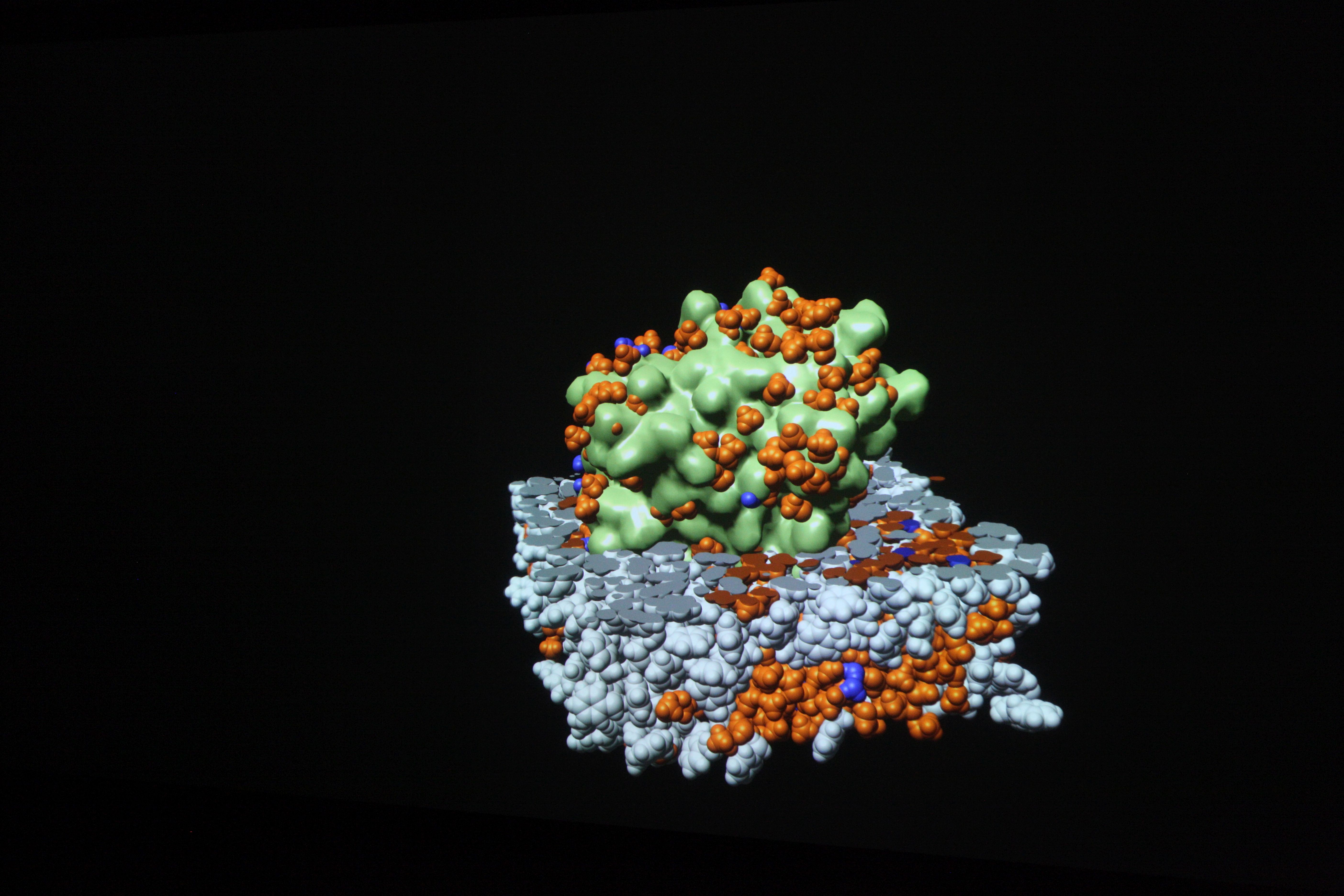
University of Stuttgart / VISUS

University of Stuttgart / VISUS
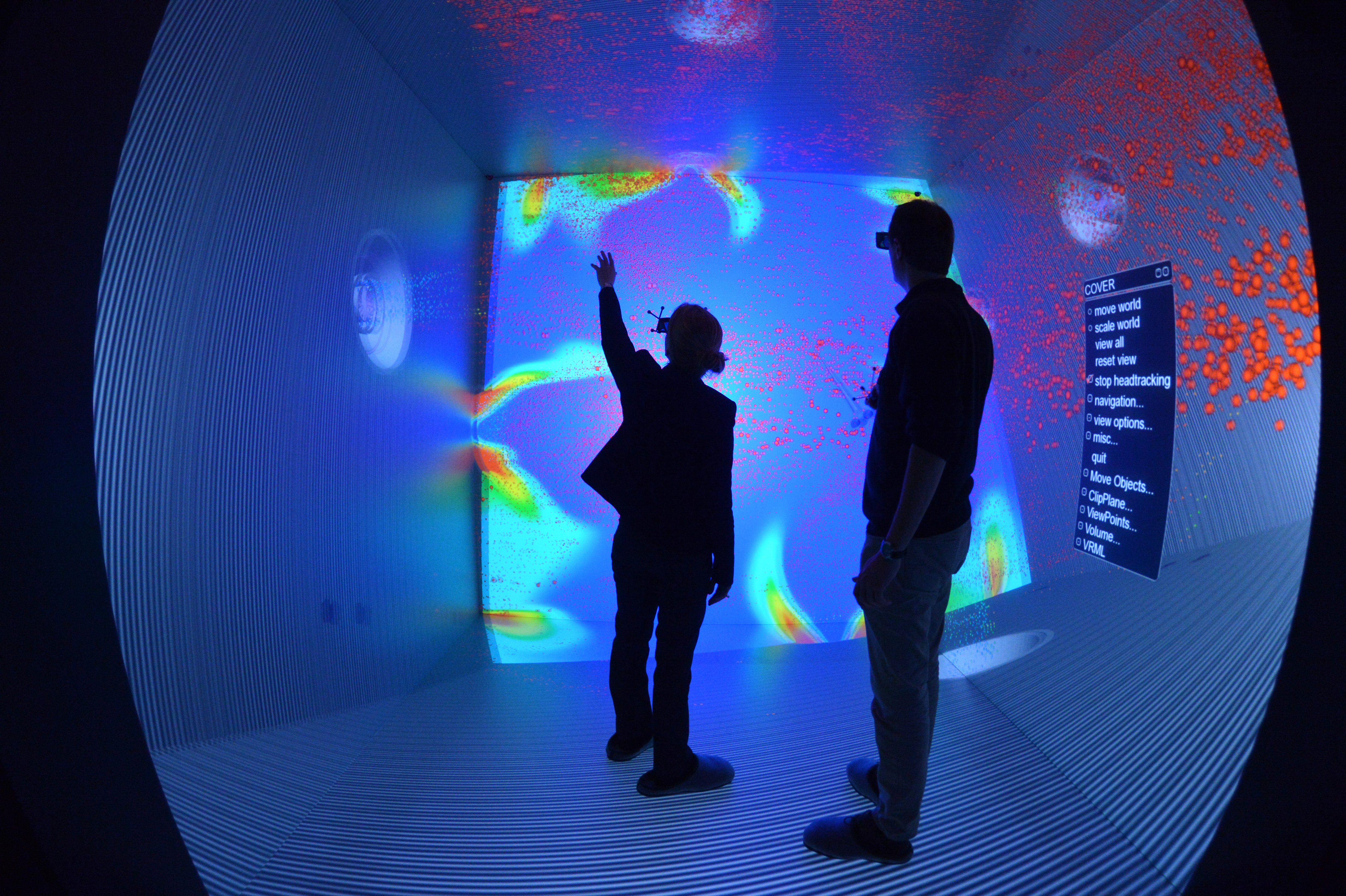
University of Stuttgart / David Ausserhofer
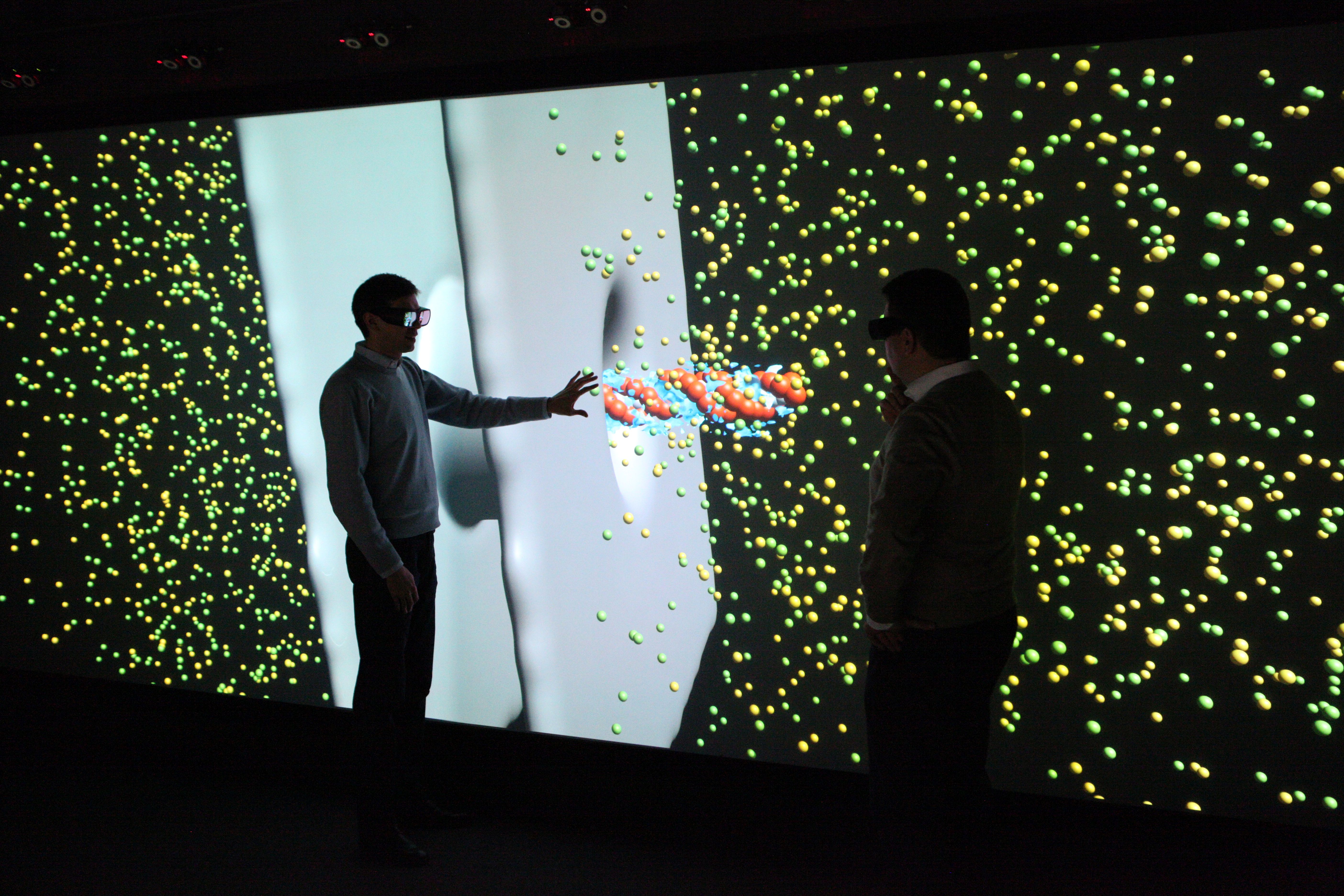
University of Stuttgart / VISUS / SFB 716
Making the hidden visible: How data becomes images

University of Stuttgart / VISUS
The results of computer simulations are data sets. More and more details, larger systems and longer periods of time are what experts from numerous disciplines want to look at in order to gain new insights. Finding answers in this flood of data increasingly resembles searching for the proverbial “needle in a haystack”. Pictures or graphics of the abstract information are essential for this. They make visible what would otherwise remain hidden from the human eye.
The weather map in the evening, car navigation or the election results of the current federal election – in our everyday lives, images often show us what has been compiled in elaborate measurements, extensive data collections or complicated calculations. Scientists and developers are no different. Complex information or processes are most easily examined in graphical representations. But what has to happen so that the weather map flickers across the screen or an engineer can examine his idea on the computer?
Thanks to visualization, data sets generated in computer simulations are converted into visual images. This makes the seemingly unmanageable information interpretable and analyzable.
Visualizations are mostly interactive and three-dimensional. They can be viewed from all sides, individual parameters can be shown or hidden and special features can be highlighted. The display on high-resolution large projection screens also provides a comprehensive impression of all details. With interactive real-time graphics, conceptual considerations and possible implementation variants can be experienced at an early stage.
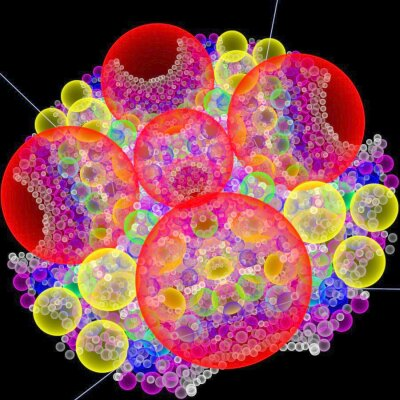
University of Stuttgart / VISUS
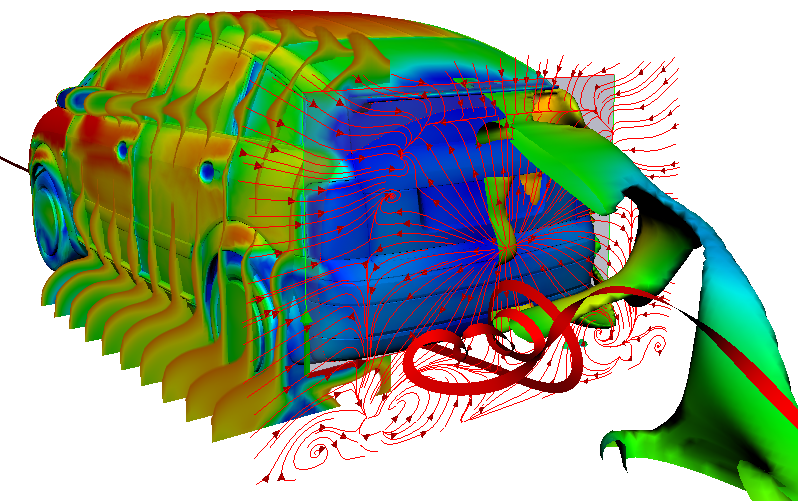
University of Stuttgart / VISUS
Step by step – the visualization process
01 Raw data
At the beginning of the visualization process there is an abstract, unmanageable amount of numbers – the data. Not all information can always be represented graphically. This is why scientists determine what is important to answer a question. This means that the data is filtered so that only those parts relevant to the analysis are visualized.
02 Mapping
For the filtered data it is now defined how they are graphically displayed. For example, atoms are usually visualized as spheres.
03 Rendering
The graphical representation of the previously selected representations is calculated. In addition, the angle from which the data is to be displayed is determined.
04 Finale Visualisierung
The result is a three-dimensional, interactive image that can be used to analyze the information selected in the first step.
Pretty Porous
03
03
Research and Tools
How does porous media research work?
Porous media are researched by means of real laboratory experiments, with computer models and simulations as well as with visualizations. Theory and practice work closely together. The researchers combine the work in the laboratory with the work on the computer.
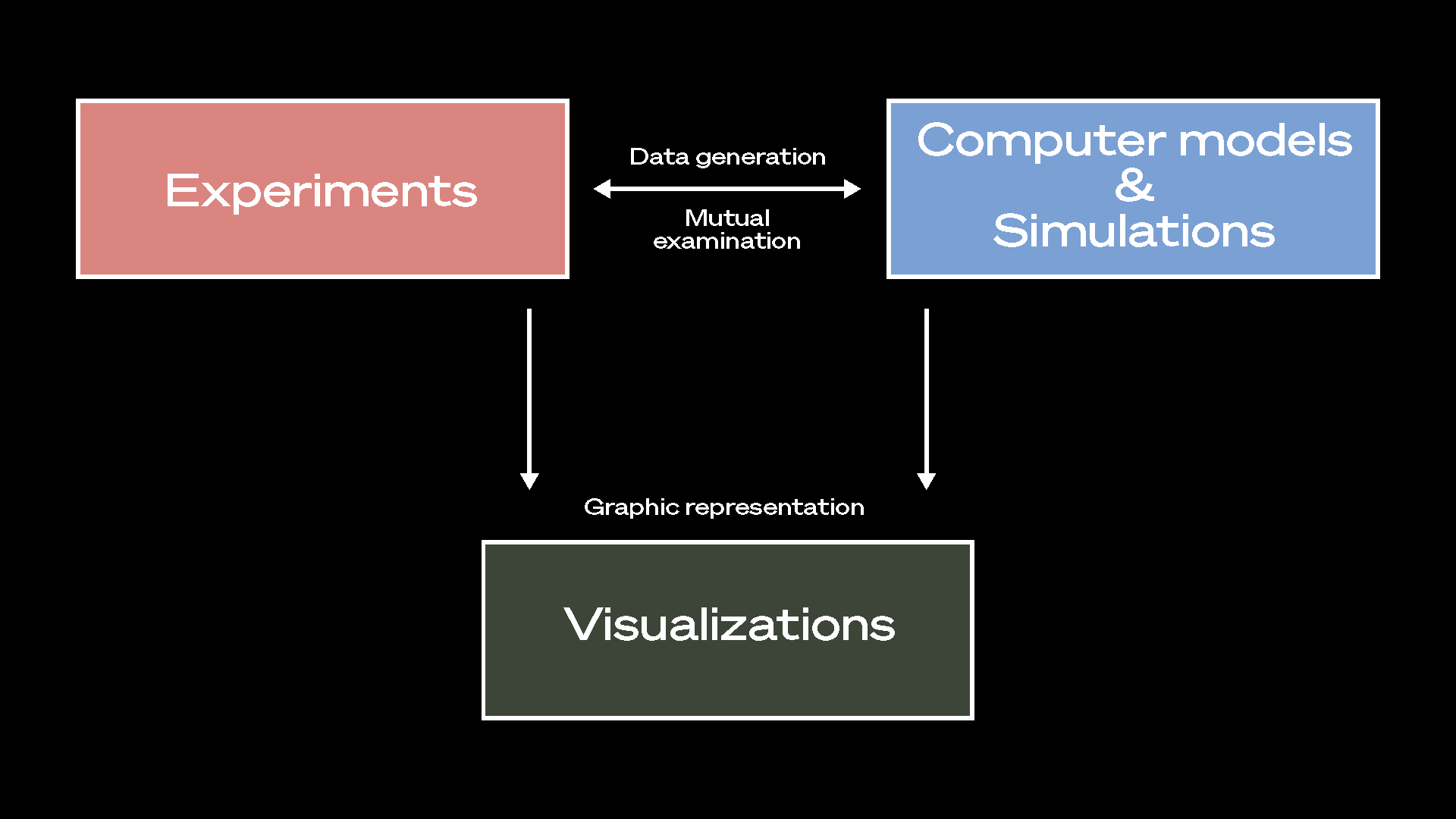
Credits: University of Stuttgart / SFB 1313
